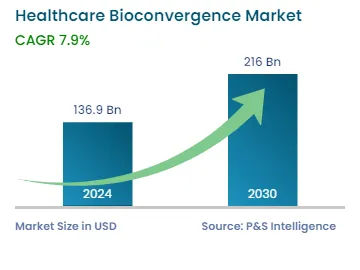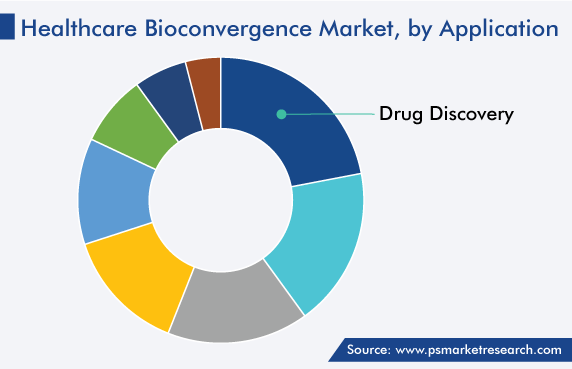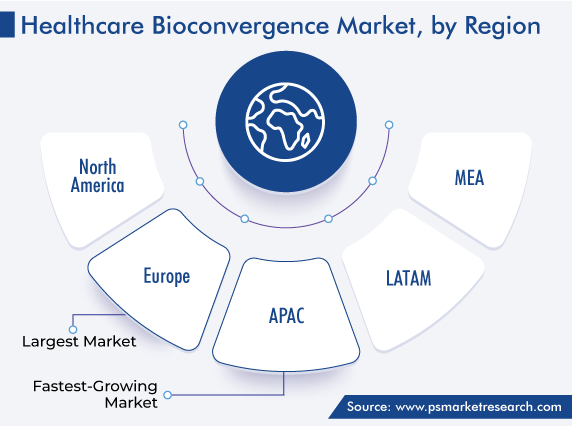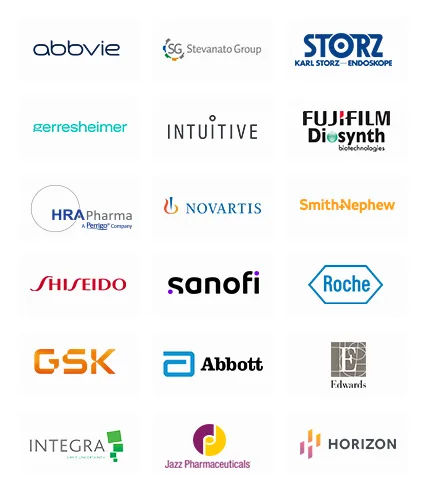Market Statistics
| Study Period | 2019 - 2030 |
| 2024 Market Size | USD 136.9 Billion |
| 2030 Forecast | USD 216 Billion |
| Growth Rate(CAGR) | 7.9% |
| Largest Region | Europe |
| Fastest Growing Region | Asia-Pacific |
| Nature of the Market | Fragmented |
Report Code: 12612
Get a Comprehensive Overview of the Healthcare Bioconvergence Market Report Prepared by P&S Intelligence, Segmented by Application (Drug Discovery, Nanorobotics for Drug Delivery, Regenerative Medicine, Diagnostic and Biological Sensors, Bioelectronics, Engineered Living Materials, Optogenetics, Precision Medicine), End User (Pharmaceutical & Biotechnology Companies, CRO), and Geographic Regions. This Report Provides Insights from 2019 to 2030.
| Study Period | 2019 - 2030 |
| 2024 Market Size | USD 136.9 Billion |
| 2030 Forecast | USD 216 Billion |
| Growth Rate(CAGR) | 7.9% |
| Largest Region | Europe |
| Fastest Growing Region | Asia-Pacific |
| Nature of the Market | Fragmented |

Explore the market potential with our data-driven report
The healthcare bioconvergence market size stood at USD 136.9 billion in 2024, and it is expected to advance at 7.9% CAGR during 2024–2030, to reach USD 216 billion by 2030.
The market is growing because of the rising number of elderly people and the increasing use of stem cells for regenerating tissues, organs, and injured cells. Additionally, the preference of end users for combinations of advanced technologies, including machine learning, robotics, ergonomics, and AI, with cloud computing and biology, will contribute toward the industry development over the forecast period.
Moreover, bioconvergence is used for the delivery of drugs manufactured from material science, as well as for nano-robotics, bio-sensors, and hybrid equipment, so as to improve monitoring and diagnosis. Other examples are the interactions of the brain and computer in order to study the precipitating activities and causes of neurological diseases and the usage of hybrid biochemical components for the production of operational 3D tissue cells for stem cell therapy.
In 2021, the Government of the U.S. announced USD 1.7 billion in investment for improving the methods used to identify, track, and prevent the spread of different strains of COVID-19 and develop infrastructure for the genomic sequencing requirements that arise in the future. Due to the rising funding by governments for the enhancement of their healthcare sector, the usage of the bioconvergence approach is surging.
Essentially, with the increasing number of patients with chronic disorders, the demand for bioconvergence has increased, which is forcing the key players to put in efforts and focus on new discoveries in this area. It has been a major challenge for the medical community to make drug delivery more accurate. Nano-robots created from a combination of bioconvergence and biological systems, to aid in delivering drugs to specific cells and organs, have offered a solution to this conundrum.
The number of clinical trials initiated by both private and government medical organizations is increasing rapidly in developed countries, such as the U.S., France, Canada, Germany, and the U.K., which, in turn, is driving the adoption of advanced bioconvergence techniques. This is especially true of trials with their main focus on providing rapid treatments, enabled by the swift and accurate diagnosis of chronic disorders. Thus, the increasing spending on the bioconvergence technology and its rising usage in research & development for advancements in the healthcare sector are driving the market.
For instance, Israel launched a five-year plan with an investment of approximately USD 127 million to advance the field of bioconvergence in May 2022. The establishment of R&D centers, encouragement to startups, academic institutions, and consortia of companies in the field, and provision of training and placement to biologists are the key focus areas of this program.
The Fourth Industrial Revolution is changing the way diagnosis and treatment are done and accelerating the process of the discovery of new drugs. The adoption of various technologies, including IoT and AI, is driving this revolution. Amidst this, healthcare is becoming a cyber–physical system with wearables, IoT, RFID, intelligent sensors, medical robots, and many other objects and technologies, which are now also armed with big data analysis, cloud computing, and decision support methods.
Via early risk assessment and accurate preventive strategies, the onset of chronic diseases can be deferred, and those that have emerged can be better treated or managed. With the incorporation of digital and genetic technologies, the complications of chronic diseases can also be recognized and resolved. These new capabilities are enabling gene therapies to be created faster and more cost-effectively, by offering doctors and researchers richer clinical insights. Moreover, the demand for bioconvergence is increasing because of the shift toward value-based care approaches.
The drug discovery category held the largest share, of around 22%, in 2022, under the application segment, because of the increasing burden of cardiovascular, cancer, and CNS-related disorders, rising costs of medical treatments, and the patent expiry of various medications. According to several government records, in the U.S., around 1.9 million new cancer cases were recorded and around 609,360 deaths were caused by it in 2022.
Moreover, the rising geriatric population, which is suffering from various diseases, elevates the need for drug discoveries, which, in turn, fuels the growth of the market. Furthermore, cutting-edge engineering solutions are required to streamline and accelerate the development of new and advanced drugs and lower the costs of the entire process, to, ultimately, provide fast and precise care.
The regenerative medicine category is expected to showcase the fastest growth, at a CAGR of around 8%, over the coming years, attributed to the ability of such treatments to heal or replace damaged tissues, cells, as well as organs that have suffered trauma or deformed due to disorders or age.
Moreover, presently, regenerative medicines have gained high traction in a wide range of medical subspecialties, such as hepatology, neurology, diabetes, trauma, and oncology, because of the rapidly increasing population above 60 years of age and the rising demand for the early detection of diseases.
Furthermore, there is wide traction for stem-cell-based therapies because of their effectiveness, safety, and capability of healing and replacing injured or damaged cells, tissues, and organs.
The market is also growing in the bioelectronics category, attributed to the emergence of advanced technological capabilities that combine biomolecules with electronics, thus enabling the development of a wide range of functional devices.
Similarly, the usage of bioconvergence in precision medicine is growing because of the latter’s increasing adoption and the surging awareness about its benefits among patients. Researchers engaged in the clinical trials of precision medicine are increasingly using IoT, which is already transforming the healthcare system by providing promising technological, economic, and social prospects. Precision medicine aids in observing and treating patients according to their individual physiological profiles. Thus, due to the usage of advanced technologies and various novel tools, such as AI-powered applications and digital diagnostic platforms, the demand for bioconvergence is increasing. Precision medicine studies help doctors in identifying the underlying cause of diseases, which, in turn, aids in recognizing the drug that is best suited for the patient.
For this, biomarkers are used for the determination of the risk and to check how the patient’s body reacts to both the disease and the treatment. IoT can be integrated into connected diagnostic devices, such as those used to measure blood glucose, heart rate, and blood pressure, to gather real-time data on the patient’s status. Thus, the increasing utilization of IoT in precision medicine will aid in the growth of the market.

Pharmaceutical and biotechnology companies are growing at a considerable rate, attributed to the rapidly increasing number of clinical trials and the rising adoption of advanced techniques by them for drug development. These companies are aiming to bring medicines faster, more efficiently, and at lower costs, along with focusing on their safety for patients. Moreover, extensive research is being conducted on mRNA’s applicability in treating non-communicable diseases, such as cancer.
Drive strategic growth with comprehensive market analysis
Europe has the leading position in the healthcare bioconvergence market, and it will hold the same position till 2030, with a value of USD 73 billion.
The market in the region is growing attributed to the existence of leading research institutes, medical centers, and hospitals. For instance, in February 2021, a U.K.-based medical research firm, LifeArc, supported the work of the Gen OMICC COVID-19 project by announcing funding of USD 5.74 million. The funding was to help the project in sample gathering and processing, patient enrollment, as well as patient bioinformatics analysis. Moreover, the region has a robust medical industry, which propels the demand for new-generation healthcare technologies.

Based on Application
Based on End User
Geographical Analysis
The market for healthcare bioconvergence solutions valued USD 136.9 billion in 2024.
A CAGR of 7.9% is expected in the healthcare bioconvergence industry over this decade.
Drug discovery applications dominate the market for healthcare bioconvergence solutions, and regenerative medicine will grow the fastest.
The healthcare bioconvergence industry is growing with the rising adoption of AI, IoT, big data analytics, wearable sensors, and robotics in medicine.
Europe is the largest market for healthcare bioconvergence solutions and APAC the most lucrative.
Want a report tailored exactly to your business need?
Request CustomizationLeading companies across industries trust us to deliver data-driven insights and innovative solutions for their most critical decisions. From data-driven strategies to actionable insights, we empower the decision-makers who shape industries and define the future. From Fortune 500 companies to innovative startups, we are proud to partner with organisations that drive progress in their industries.


Working with P&S Intelligence and their team was an absolute pleasure – their awareness of timelines and commitment to value greatly contributed to our project's success. Eagerly anticipating future collaborations.
McKinsey & Company
IndiaOur insights into the minutest levels of the markets, including the latest trends and competitive landscape, give you all the answers you need to take your business to new heights
We take a cautious approach to protecting your personal and confidential information. Trust is the strongest bond that connects us and our clients, and trust we build by complying with all international and domestic data protection and privacy laws
Customize the Report to Align with Your Business Objectives
Request the Free Sample Pages